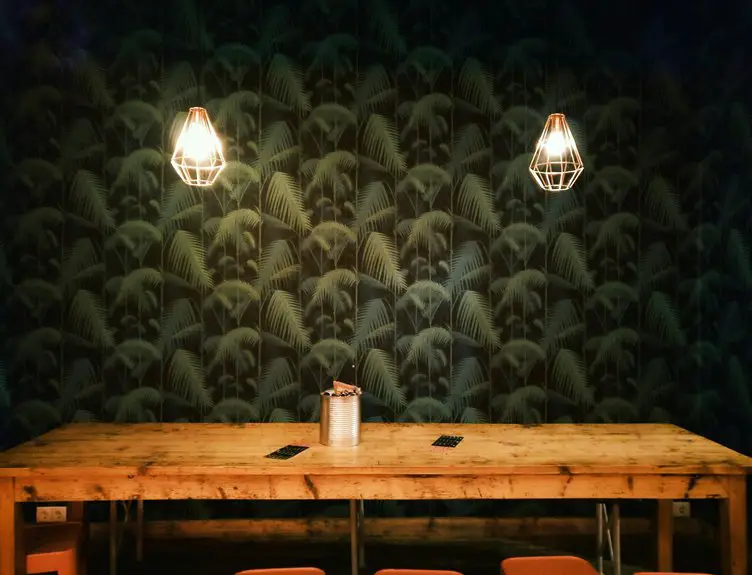To create a relaxing workspace, focus on soft, ambient lighting that sets a calming tone. Mix layered light sources for versatility, like adjustable desk lamps for tasks and pendant lights for general illumination. Incorporate natural light by positioning your desk near windows and using sheer curtains to diffuse bright sunlight. Consider warm or neutral color temperatures to enhance your mood and keep your energy up. Explore more ideas to transform your workspace into an inviting retreat.
Table of Contents
Key Takeaways
- Use warm white lighting (2700K-3000K) to create a cozy, relaxed atmosphere ideal for brainstorming and creative tasks.
- Incorporate soft, diffused ambient light to minimize harsh shadows and reduce eye strain during long work sessions.
- Layer lighting by combining ambient, task, and accent options for a versatile and inviting workspace.
- Position your desk near windows to maximize natural light, enhancing focus and overall mood while working.
- Choose energy-efficient LED fixtures that reflect your personal style and complement your workspace décor for an aesthetically pleasing environment.
Understanding the Importance of Ambient Lighting
When you think about creating a productive workspace, you can’t overlook the role of ambient lighting. It sets the mood and greatly impacts your focus and energy levels. Poor lighting can lead to eye strain and fatigue, making it hard to concentrate.
By choosing the right ambient lighting, you create a warm, inviting atmosphere that encourages creativity and productivity. Soft, diffused light helps reduce harsh shadows, allowing you to work comfortably for longer periods.
Additionally, ambient lighting can enhance your workspace’s aesthetic appeal, making it a place you enjoy spending time in. Remember, finding the perfect balance is key; too bright can be distracting, while too dim can hinder your performance.
Prioritize ambient lighting for a successful work environment.
Layering Light: Combining Different Sources
While ambient lighting lays the foundation for a productive workspace, layering different light sources can elevate your setup even further.
By combining ambient, task, and accent lighting, you create a versatile environment that meets all your needs. Start with soft ambient light to set a calming tone, and then add focused task lighting for specific activities like reading or writing.
Combining ambient, task, and accent lighting creates a versatile workspace that enhances comfort and functionality for all your activities.
Consider adjustable desk lamps or wall sconces to direct light where you need it most. Finally, incorporate accent lighting—like decorative fixtures or LED strips—to highlight artwork or architectural features.
This layered approach not only adds depth and interest but also allows you to adjust the mood based on your tasks, enhancing both comfort and functionality in your workspace.
Choosing the Right Light Fixtures for Your Workspace
Selecting the right light fixtures can greatly enhance your workspace, complementing the layered lighting approach you’ve established.
Start by considering your needs—do you require focused task lighting or softer ambient light? For task areas, opt for adjustable desk lamps or wall-mounted lights that direct light where you need it most.
Pendant lights can add a stylish touch while providing general illumination. Don’t forget about the aesthetic; choose fixtures that reflect your personal style and fit the overall décor.
A mix of materials, like metal and wood, can create warmth and interest.
Finally, think about energy efficiency—LED options not only save energy but also last longer, making them a smart choice for your workspace.
Incorporating Natural Light
Incorporating natural light into your workspace not only boosts your mood but also enhances productivity. Position your desk near windows to take full advantage of daylight. If possible, opt for a room with large windows or glass doors that invite sunlight in.
You can also consider using sheer curtains to soften harsh sunlight while still allowing ample light to filter through. Reflective surfaces, like mirrors or light-colored walls, can help amplify natural light, brightening your space even more.
If your workspace feels dark, trim back outdoor foliage to improve the view and light access. Finally, take breaks outside; even a few minutes in natural light can recharge your energy and creativity, making your workspace feel more invigorating and inviting.
Utilizing Color Temperature for Mood Enhancement
Understanding how color temperature affects your workspace can greatly enhance your mood and productivity. Choosing the right color temperature for your lighting can create a more inviting atmosphere.
Here are some tips to take into account:
- Warm White (2700K-3000K): This creates a cozy, relaxed vibe, perfect for winding down or brainstorming new ideas.
- Neutral White (3500K-4100K): This range provides a balanced, clear light that enhances focus, making it ideal for tasks requiring concentration.
- Cool White (5000K-6500K): This bright light mimics daylight, energizing your space and boosting alertness, great for collaborative work or creative sessions.
Frequently Asked Questions
What Are the Best Light Bulbs for Ambient Lighting?
When choosing light bulbs for ambient lighting, consider LED bulbs for energy efficiency. Soft white or warm white bulbs create a cozy feel, while dimmable options let you customize brightness, ensuring the perfect atmosphere for you.
How Does Ambient Lighting Affect Productivity?
Ambient lighting boosts your productivity by reducing eye strain and creating a comfortable atmosphere. You’ll find it easier to focus and stay motivated when your workspace feels inviting and well-lit, enhancing your overall work experience.
Can I Use Smart Lighting for Ambiance?
Absolutely, you can use smart lighting for ambiance! It lets you adjust brightness and color easily, creating the perfect atmosphere. With smart controls, you’ll enhance your environment and boost your mood effortlessly.
What Are Some DIY Ambient Lighting Solutions?
You can create DIY ambient lighting solutions by using string lights, repurposing old lamps with soft bulbs, or making lanterns from mason jars. These options add warmth and character to your space without breaking the bank.
How Often Should I Change My Light Fixtures?
You should change your light fixtures every five to ten years, depending on wear and tear. If you notice flickering or inconsistent brightness, it’s time for a replacement to guarantee ideal lighting in your space.



